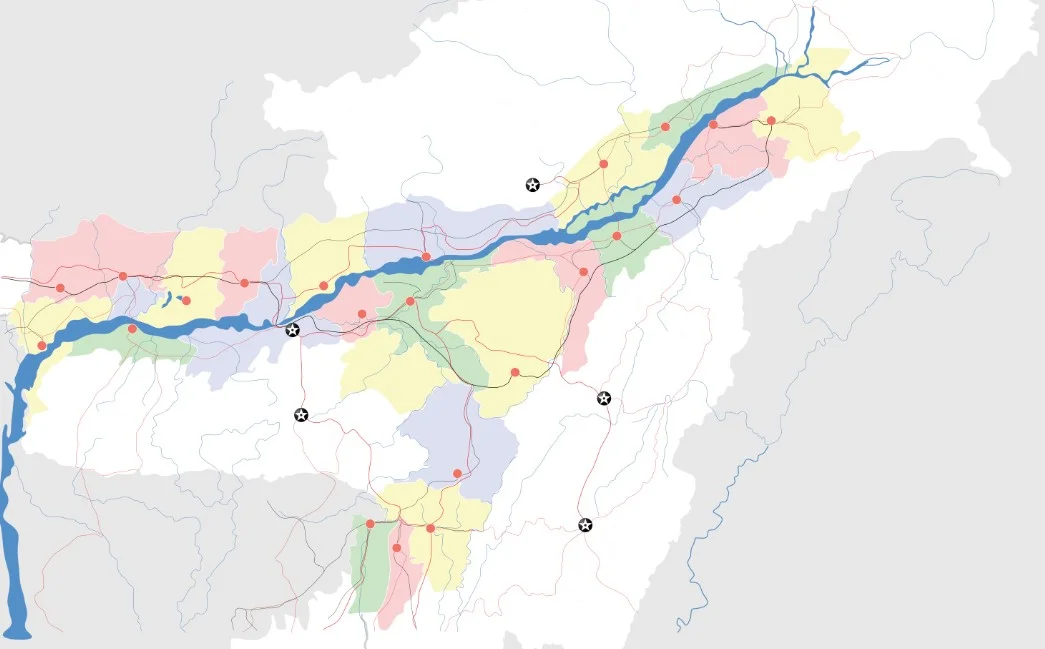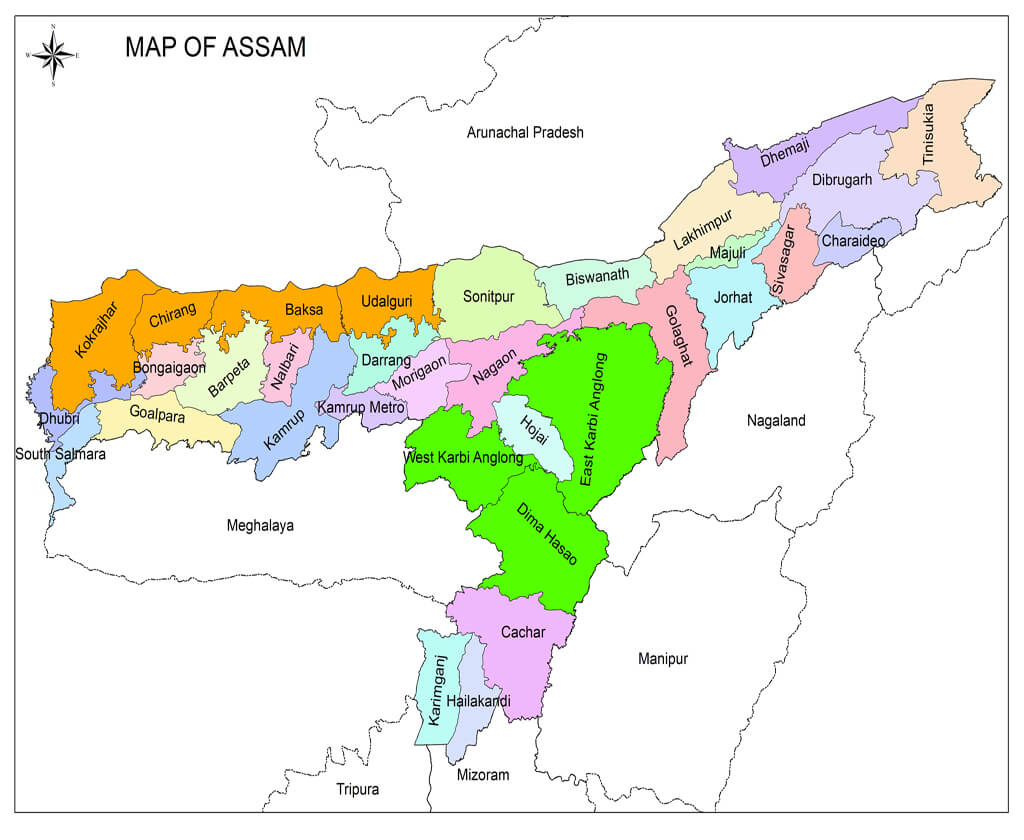
Assam, a state nestled in the northeastern part of India, boasts a rich cultural heritage, diverse landscapes, and a vibrant community. One of the administrative facets that contribute to the state’s uniqueness is its districts. As of 2024, Assam is demarcated into 31 Districts of Assam, each with its own distinct identity and characteristics. In this article, we will explore the list of these districts.
The following table contains the list of 35 districts of Assam with respected populations, as per the 2011 Census:
| S. No | Name of District | Population |
|---|---|---|
| 1. | Baksa | 950,075 |
| 2. | Barpeta | 1,693,622 |
| 3. | Bongaigaon | 738,804 |
| 4. | Cachar | 1,736,617 |
| 5. | Charaideo | 471,418 |
| 6. | Chirang | 482,162 |
| 7. | Darrang | 928,500 |
| 8. | Dhemaji | 686,133 |
| 9. | Dhubri | 1,949,258 |
| 10. | Dibrugarh | 1,326,335 |
| 11. | Dima Hasao | 214,102 |
| 12. | Goalpara | 1,008,183 |
| 13. | Golaghat | 1,066,888 |
| 14. | Jorhat | 1,092,256 |
| 15. | Kamrup Metropolitan | 1,253,938 |
| 16. | Kamrup | 1,517,542 |
| 17. | Karbi Anglong | 956,313 |
| 18. | Karimganj | 1,228,686 |
| 19. | Kokrajhar | 887,142 |
| 20. | Lakhimpur | 1,042,137 |
| 21. | Majuli | 1,67,304 |
| 22. | Morigaon | 957,423 |
| 23. | Nagaon | 2,823,768 |
| 24. | Nalbari | 771,639 |
| 25. | Sivasagar | 1,151,050 |
| 26. | Sonitpur | 1,924,110 |
| 27. | South Salmara- Mankachar | 457918 |
| 28. | Tinsukia | 1,327,929 |
| 29. | Udalguri | 831,668 |
| 30. | West Karbi Anglong | 295,358 |
| 31. | Biswanath | 612,491 |
| 32. | Hojai | 931,218 |
| 33. | Bajali | 324,739 |
| 34. | Tamulpur | 389,150 |
| 35. | Hailakandi | 33,637 |
Districts of Assam as per the Govt. records:
Bajali District
Bajali District: Emerging Cultural & Educational Hub
Bajali, carved out of Barpeta in 2021, is a district in Lower Assam with its headquarters at Pathsala. Known for educational institutions like Bajali College and rich cultural roots in Ankia Naat, the district blends tradition with progress. With fertile alluvial plains, Bajali thrives on rice, mustard farming, handloom, and fishing. Rivers like Kaldia and Pahumara support agriculture and irrigation. Reinstated as a district after brief merger in 2023, Bajali continues to grow with strong connectivity via NH-31 and rising youth-driven initiatives in language, literature, and development.
Baksa District: Where Culture Meets Conservation
Baksa, a scenic district in Lower Assam bordering Bhutan, was formed in 2003 under the Bodoland Territorial Region. With its headquarters at Mushalpur, the district showcases Bodo heritage through festivals like Kherai Puja, dances such as Bagurumba, and vibrant handloom traditions. Baksa also hosts parts of Manas National Park—a UNESCO World Heritage Site known for rare wildlife and the Manas River’s beauty. Agriculture is the district’s backbone, while eco-tourism and cross-border trade are growing sectors. Rich in culture and nature, Baksa stands as one of Assam’s most distinctive districts.
Barpeta District: The Spiritual and Cultural Heart of Barpeta District: Land of Satras and Spiritual Heritage
Barpeta, in Western Assam, is famed as the “Land of Satras,” with deep roots in neo-Vaishnavite culture. The Barpeta Satra, founded by Madhabdev, stands as a center for religious learning, classical dance, and Ankia Naat theatre. The district thrives agriculturally with rice, jute, and mustard, supported by the Beki and Manas rivers. Barpeta town serves as both the cultural and administrative hub, while festivals like Raas Mahotsav reflect its artistic spirit. With growing infrastructure and proximity to Manas National Park, Barpeta is a vital symbol of Assam’s spiritual and cultural richness.
Biswanath District: Assam’s New Growth Corridor
Biswanath, formed in 2015, is a young district carved out of Sonitpur. With its headquarters at Biswanath Chariali along NH-15, it enjoys strong connectivity across Assam. Named after the sacred Biswanath Ghat on the Brahmaputra—home to the historic Biswanath Mandir or ‘Gupta Kashi of the East’—the district blends spiritual heritage with strategic relevance. Tea gardens, paddy fields, and proximity to Kaziranga’s Biswanath division support both agriculture and eco-tourism. Rapid development in infrastructure, education, and healthcare makes Biswanath a rising administrative and cultural hub in the state.
Bongaigaon District: Assam’s Industrial and Cultural Nucleus
Established in 1989, Bongaigaon is a key district in Western Assam, carved from Goalpara and Kokrajhar. Anchored by Bongaigaon town, it houses the Bongaigaon Refinery—one of Northeast India’s major industrial assets under IOCL—driving regional economic growth. Strategically placed along the Brahmaputra, the district balances industry with nature, with forested zones and parts of Manas National Park enriching its landscape. Culturally diverse, it thrives on Assamese, Bodo, and Bengali traditions. Excellent road and rail links make Bongaigaon a vital administrative, commercial, and cultural gateway for Assam.
Cachar District: Cultural and Academic Hub of Barak Valley
Cachar, with Silchar as its headquarters, lies in southern Assam and forms the core of the Barak Valley. Known for its linguistic and cultural diversity—home to Bengali, Manipuri, Assamese, Bishnupriya, and Dimasa communities—it stands as a symbol of peaceful coexistence. Silchar is a prominent educational center, hosting Assam University. The district holds historical importance due to the 1961 Bengali Language Movement. With rich tea gardens, fertile lands, and vibrant festivals, Cachar blends culture, education, and economic vitality in Assam’s southern landscape.
Charaideo District: Legacy of the Ahom Dynasty
Charaideo, carved from Sivasagar in 2016, is the historical seat of Assam’s Ahom dynasty. Known for its ancient Maidams—royal burial mounds resembling pyramids—this district reflects the architectural and cultural brilliance of Ahom rule. The headquarters, Sonari, is a growing urban center. Charaideo’s economy thrives on tea, agriculture, and handloom. Rivers like Disang and Burhidihing enrich its plains. Celebrations like Me-Dam-Me-Phi uphold its deep-rooted spiritual heritage, making Charaideo a timeless symbol of Assam’s royal past.
Chirang District: Nature and Tribal Culture in Harmony
Located in Western Assam under the Bodoland Territorial Region, Chirang was formed in 2004 with Kajalgaon as its headquarters. The district features rich biodiversity, scenic rivers like Aie and Manas, and shares part of the UNESCO-listed Manas National Park. Chirang is home to Bodo, Rabha, Assamese, and Bengali communities, known for peaceful coexistence and cultural vibrancy. Its economy is driven by agriculture, tea, bamboo crafts, and handloom. With growing infrastructure, Chirang is a serene destination blending nature, heritage, and indigenous pride.
Darrang District: Where Assam’s Heritage Lives On
Situated in central Assam with Mangaldoi as its headquarters, Darrang is among the state’s oldest districts, rich in history and culture. Known for sites like Patharughat and Rangamati Mosque, the district reflects Assam’s spiritual and political legacy. Home to Assamese, Bodo, Bengali, and Garo communities, Darrang celebrates diversity through festivals, handloom, and shared traditions. With fertile plains fed by the Brahmaputra, agriculture thrives here alongside growing infrastructure and education. Darrang stands as a model of cultural pride and progressive development.
Dhemaji District: Assam’s Land of Rivers and Resilience
Located in northeastern Assam along the Arunachal border, Dhemaji is shaped by rivers like the Brahmaputra and Jiadhal. Though flood-prone, its fertile lands support rice, mustard, and fisheries, sustaining a strong agrarian economy. Home to Mishing, Deori, Sonowal Kachari, and Assamese communities, the district celebrates rich tribal culture through festivals like Ali-Ai-Ligang and Magh Bihu. Scenic landscapes, river islands, and rising connectivity to Arunachal make Dhemaji a vital and vibrant part of Upper Assam.
Dhubri District: Assam’s Historic River Gateway of Cultures and Commerce
Dhubri, nestled in western Assam along the Brahmaputra and Gadadhar rivers, is known as the “Land of River Ports.” Once a vital trade hub during colonial times, it now reclaims its strategic role under India’s Act East Policy, connecting Assam with Bangladesh and West Bengal. The district reflects remarkable cultural harmony, with Assamese, Bengali, Rajbongshi, Muslim, Hindu, and tribal communities coexisting peacefully.
Iconic sites like Panchpeer Dargah, Sri Guru Tegh Bahadur Gurudwara, and Mahadev Temple make Dhubri a spiritual and historical destination. Its fertile plains support jute, rice, and mustard cultivation, while the riverine landscape fosters fishing and inland trade. With vibrant festivals like Bihu, Eid, Durga Puja, and Magh Mela, Dhubri stands as a living symbol of Assam’s pluralistic legacy and growing economic importance.
Dibrugarh District: The Tea Capital of India
Dibrugarh, famously known as the Tea City of India, is one of Assam’s most economically significant districts. Located on the banks of the Brahmaputra River, it serves as a major center for tea production, petroleum industries, and education in Upper Assam.
The district is home to some of the largest tea estates in the world, with world-renowned gardens like Moran, Doom Dooma, and Naharkatia contributing significantly to India’s global tea exports. The presence of Oil India Limited (OIL) and other petroleum enterprises also boosts Dibrugarh’s industrial profile.
Beyond commerce, Dibrugarh offers a tranquil landscape enriched by riverine beauty, lush plantations, and a rapidly urbanizing environment. It also boasts premier institutions such as Dibrugarh University and Assam Medical College, making it a hub for both education and healthcare in the Northeast.
With the launch of infrastructure projects like the Bogibeel Bridge and improved connectivity via air, rail, and waterways, Dibrugarh is positioning itself as a gateway to Southeast Asia under India’s Act East Policy.
Dima Hasao District: The Hidden Gem of Assam’s Hills
Dima Hasao, formerly known as North Cachar Hills, is a captivating district nestled in the southern part of Assam. Known for its undulating hills, dense forests, and ethnic diversity, the district is a paradise for nature lovers, trekkers, and cultural explorers.
Its administrative center, Haflong, is Assam’s only hill station, offering breathtaking views and a cool climate year-round. Dima Hasao is home to multiple indigenous tribes, including the Dimasa, Zeme Naga, Hmar, and Kuki communities—each contributing unique customs, languages, and vibrant festivals.
The region also features tourist attractions like the Haflong Lake, Jatinga (famous for its bird phenomenon), and the scenic Maibang ruins, echoing the district’s historical significance as the former capital of the Dimasa kingdom.
Strategically located along the Lumding–Silchar railway line, the district holds potential for eco-tourism and adventure tourism in Assam. With ongoing infrastructural development, Dima Hasao is emerging as a serene yet culturally rich destination awaiting discovery.
Goalpara District: A Living Historical Tapestry of Assam
Goalpara, situated in Lower Assam, is a district that beautifully intertwines heritage, spirituality, and natural charm. It is one of Assam’s oldest districts, with roots tracing back to the ancient kingdom of Kamrup. The region is known for its religious harmony, housing revered landmarks such as the Sri Sri Suryapahar—a unique archaeological site with Hindu, Buddhist, and Jain relics—along with historic mosques, temples, and the sacred Pancharatna Ghat on the Brahmaputra River.
Goalpara is also rich in tribal culture, predominantly of the Rabha and Garo communities, contributing to its vibrant folk traditions. The district’s proximity to Meghalaya and its lush green hills enhance its ecotourism potential.
With a blend of history, culture, and nature, Goalpara stands as a culturally enriched district that connects Assam’s past with its present.
Golaghat District: Gateway to Kaziranga and Assam’s Tea Belt
Golaghat, located in Upper Assam, is popularly known as the Gateway to Kaziranga National Park, a UNESCO World Heritage Site famed for the one-horned rhinoceros. The district is also part of Assam’s vast tea-producing region, with sprawling tea estates that date back to the British era.
Golaghat’s cultural landscape is equally rich, with vibrant folk traditions, tribal heritage, and festivals celebrated by communities like the Mishing and Karbis. The town of Golaghat itself serves as a historic center, housing educational institutions, colonial-era churches, and museums.
Well-connected by road and rail, Golaghat plays a key role in eco-tourism, agriculture, and heritage conservation, making it a destination where nature, culture, and economy thrive in harmony.
Hailakandi District: Cultural Diversity in the Barak Valley
Hailakandi, located in the southernmost region of Assam, is one of the three vital districts of Assam that make up the Barak Valley, alongside Cachar and Karimganj. Covering an area of about 1,327 square kilometers, this district is known for its lush greenery, agricultural significance, and multilingual society.
With a population representing Bengali, Manipuri, Dimasa, Hindi, and Assamese communities, Hailakandi stands as a fine example of intercultural unity and coexistence. Bengali is the most widely spoken language, and Islam and Hinduism are the major religions, with several mosques and temples contributing to the region’s spiritual life.
The Katakhal River, a tributary of the Barak, meanders through Hailakandi and supports fertile lands ideal for paddy cultivation, vegetable farming, and horticulture. The district also has a growing interest in handicrafts, small-scale industries, and educational development, especially in towns like Hailakandi and Lala.
Festivals such as Durga Puja, Eid, Bihu, and Muharram are celebrated with harmony and mutual respect, highlighting the secular fabric of the region. Its vibrant cultural expressions, religious tolerance, and scenic rural landscapes make Hailakandi a lesser-known yet culturally significant part of Assam.
Jorhat: Cultural and Educational Hub of Assam
Jorhat, often referred to as the Cultural Capital of Assam, is one of the most prominent districts of Assam that seamlessly blends history, heritage, education, and progressive thought. Situated on the northeastern bank of the Brahmaputra River, Jorhat played a pivotal role during the Ahom dynasty, serving as their last capital before the British annexation.
The district is home to Jorhat Science Centre and Planetarium, Tocklai Tea Research Institute (the oldest tea research station in the world), and Jagannath Barooah College, making it a prominent center for education and scientific research in the Northeast.
Culturally, Jorhat is known for its satras (Vaishnavite monasteries), Assamese literary movements, and annual festivals such as Raas Mahotsav and Bihu, which draw large crowds from across the state. The district is also a key player in Assam’s tea industry, with sprawling tea estates adding to both the economy and the scenic beauty of the region.
Jorhat’s intellectual environment, enriched by cultural pride and historical legacy, makes it not just a district—but a beacon of Assamese identity.
Kamrup Metropolitan: The Pulse of Assam’s Urban Evolution
Kamrup Metropolitan, home to Guwahati, Assam’s largest city, stands as the state’s commercial, political, and cultural powerhouse. As one of the most prominent districts of Assam, it reflects a perfect blend of tradition and modernity. With a fast-paced urban lifestyle, the district is home to Dispur, the state capital, renowned universities, advanced medical facilities, and a thriving business ecosystem. Kamrup Metropolitan plays a central role in Assam’s development story, connecting the region to national and international markets while preserving its rich Assamese identity.
Guwahati’s landmarks—Kamakhya Temple, Srimanta Sankardev Kalakshetra, Brahmaputra riverfront, and Guwahati Zoo—make Kamrup Metro both a spiritual and recreational hotspot. Its well-connected transport systems, including the LGBI Airport and railway network, further enhance its regional importance.
From vibrant markets to IT parks, Kamrup Metropolitan exemplifies urban dynamism while preserving the cultural heritage of Assam.
Kamrup: Cradle of Ancient Civilization in Assam
Kamrup district, often referred to as the gateway to Northeast India, is steeped in mythology, spirituality, and archaeological significance. With historical roots tracing back to the ancient Kamarupa Kingdom, the region is dotted with sacred temples like Madan Kamdev, Hayagriva Madhava, and archaeological ruins that echo a glorious past.
Situated on the banks of the Brahmaputra River, Kamrup is known for its cultural depth, traditional festivals, and rural charm. The district also plays a crucial role in connecting Assam to neighbouring states through its road and rail corridors.
Karbi Anglong: Land of Karbi Tribes
Karbi Anglong, one of the most culturally vibrant districts of Assam, is predominantly inhabited by the indigenous Karbi community. This hilly district paints a rich tapestry of tribal traditions, folklore, and ancestral wisdom. Covered with dense forests, misty hills, scenic waterfalls, and abundant greenery, it offers a serene window into Assam’s tribal heartland. The district celebrates traditional festivals like Rongker and Chomangkan, which embody deep spiritual beliefs and collective harmony. Karbi Anglong is also a biodiversity hotspot, with parts of the renowned Kaziranga and Nambor-Doigrung wildlife sanctuaries falling within its boundaries, making it vital for ecological preservation and indigenous heritage alike.
Karimganj: Silchar’s Twin
Karimganj, one of the districts of Assam nestled along the Barak River, is often referred to as the cultural sibling of Silchar. It forms an essential part of the Barak Valley and shares deep socio-cultural and economic ties with its neighboring districts. With scenic riverbanks, historic mosques, and colonial-era buildings, Karimganj offers a peaceful and historically rich atmosphere. Its vibrant linguistic landscape, with Bengali as the predominant language, adds a unique dimension to Assam’s cultural diversity.
Kokrajhar: Bodo Heartland
Kokrajhar, one of the important districts of Assam located in the heart of the Bodoland Territorial Region, serves as the socio-cultural nucleus of the Bodo community. The district thrives with colorful Bodo festivals like Bwisagu and Dwijing, along with traditional crafts such as weaving and bamboo artistry. Beyond its rich ethnic heritage, Kokrajhar is also recognized for its commitment to wildlife conservation, housing the Chakrashila Wildlife Sanctuary, home to the endangered golden langur.
Lakhimpur: Nature’s Bounty and Agricultural Prosperity
Lakhimpur, one of the prominent districts of Assam, is situated on the northern bank of the Brahmaputra River and is known for its agricultural productivity and ecological wealth. Blessed with fertile alluvial soil and ample rainfall, it supports rice, mustard, and vegetable farming on a large scale. The district is dotted with natural reserves like the Pabha and Ranga wildlife sanctuaries, supporting biodiversity and offering eco-tourism potential. Its traditional Assamese lifestyle remains intact in its many rural villages.
Majuli: World’s Largest River Island
Majuli, one of the prominent districts of Assam, is globally recognized as the world’s largest river island, nestled within the mighty Brahmaputra. It is the spiritual heart of the state, serving as the cradle of the 15th-century Neo-Vaishnavite movement led by Srimanta Sankardev. The district hosts numerous satras (Vaishnavite monasteries), which preserve sacred dance, music, drama, and religious literature. Majuli is also known for its scenic wetlands, migratory birds, handloom weaving, and traditional clay pottery.
Morigaon: Land of the Great One-Horned Rhinoceros
Morigaon, one of the vibrant districts of Assam located near the renowned Pobitora Wildlife Sanctuary, is synonymous with the iconic one-horned rhinoceros. With the highest rhino density in the state, it draws wildlife enthusiasts and conservationists from across the globe. Beyond its ecological prominence, Morigaon carries historical and cultural weight, with ancient temples like the Sita Jakhala Temple and mystical locales such as Mayong—famous for its folklore of magic and traditional healing practices.
Nagaon: Heart of Assam
Nagaon, often hailed as the Heart of Assam for its strategic central location and cultural legacy, is one of the most significant districts of Assam. Renowned as the birthplace of Srimanta Sankardev—Assam’s great saint-reformer and pioneer of the Bhakti movement—Nagaon holds a special place in the spiritual and cultural landscape of the state. The district boasts a strong agrarian base and is equally prominent in silk weaving, fishing, and traditional handicrafts. It shares a boundary with the iconic Kaziranga National Park, adding ecological prestige to its profile. As a growing hub for education, trade, and heritage, Nagaon continues to shape the socio-economic fabric of Assam.
Nalbari: Assamese Cultural Essence
Nalbari district resonates with the soul of Assamese culture. Known for festivals like Raas Mahotsav and the presence of ancient temples such as Hari Mandir, Nalbari stands as a bastion of tradition. The district boasts thriving literary societies, folk music institutions, and a strong educational backbone. Its rural areas are rich in paddy cultivation and traditional Assamese handloom production, especially gamusas and mekhela chadors.
Sivasagar: Ahom Architecture and Heritage
Sivasagar, once the royal seat of the Ahom dynasty, is a districts of Assam known for its profound historical and architectural importance. The remains of the Ahom palaces, including Rang Ghar, Talatal Ghar, and Sivasagar Tank, are testaments to the kingdom’s grandeur. The area’s temples—Sivadol, Vishnudol, and Devidol—still stand tall, preserving the region’s religious and architectural heritage. Sivasagar is also a center for Tai-Ahom traditions and literature.
Sonitpur: Blend of Hills and Plains
Sonitpur, one of the most geographically diverse districts of Assam, spans from the Himalayan foothills to the fertile plains along the Brahmaputra. Its administrative headquarters, Tezpur, is steeped in mythology, ancient temples, and remnants of British colonial architecture, making it a cultural and historical treasure. The district is also a hotspot for biodiversity, housing Nameri National Park and Sonai Rupai Wildlife Sanctuary, both known for their ecological richness. Adventure seekers can indulge in river rafting on the Jia Bhoroli River or explore forest trails teeming with wildlife. Sonitpur seamlessly blends natural beauty with deep-rooted traditions, making it a standout among Assam’s diverse districts.
South Salmara-Mankachar: Riverine Beauty
South Salmara-Mankachar, a districts of Assam bordering Bangladesh, lies on the fertile and flood-fed banks of the Brahmaputra. Its rural charm, expansive riverine landscapes, and interwoven Indo-Bangla cultural elements define its unique character. The district thrives on agriculture and river-based trade, while preserving local crafts, folklore, and a harmonious religious coexistence that enrich Assam’s pluralistic identity.
Tamulpur: Assam’s New Administrative Frontier
Tamulpur, one of the newly reestablished districts of Assam in the Bodoland Territorial Region, represents the state’s evolving administrative landscape. Initially created in 2022 and later dissolved before being reinstated, the district is strategically located along the Bhutan border. Rich in tribal culture and forested areas, Tamulpur is gradually emerging as a promising center for cross-border trade, eco-tourism, and socio-political development within Assam’s Bodo heartland.
Tinsukia: Land of the Rising Sun
Tinsukia, one of the easternmost districts of Assam, is renowned for its economic contributions through tea, oil, and coal industries. The region boasts heritage towns like Digboi—home to Asia’s oldest oil refinery—and rich biodiversity in the Dibru-Saikhowa National Park. Its sunrise views over the Patkai hills, vibrant Assamese and tribal festivals, and border proximity to Arunachal Pradesh make it a dynamic cultural and economic frontier.
Udalguri: Diverse Cultures of Bodoland
Udalguri, one of the culturally rich districts of Assam located in the Bodoland Territorial Region, is known for its ethnic diversity and natural beauty. The district is home to Bodos, Adivasis, Nepalis, and Assamese communities living harmoniously, enriching the local culture. Udalguri also hosts the Bornadi Wildlife Sanctuary, which shelters endangered species like the pygmy hog and hispid hare. Traditional dance forms, folk songs, and community festivals highlight the vibrant life of this district.
West Karbi Anglong: Gateway to the Karbi Hills
West Karbi Anglong, one of the scenic districts of Assam carved out from the parent Karbi Anglong district, is a rugged, forest-rich area serving as a gateway to the lesser-known Karbi Hills. With tribal settlements scattered across the terrain, the district offers an ideal setting for ecotourism and cultural exploration. Its landscapes, tribal lifestyle, and untouched forests provide a raw and immersive experience of Assam’s hill districts.
Hojai: Educational Hub and Cultural Harmony
Hojai, one of the newer districts of Assam, is an emerging hub of education and trade. Located in central Assam, it is known for its vibrant mix of cultures, with significant Bengali, Assamese, and Hindi-speaking communities. The district is home to reputed institutions like Rabindranath Tagore University and boasts a thriving small business ecosystem. Hojai’s bustling markets, cultural events, and growing infrastructure reflect its transition from a subdivision to a prominent district, actively contributing to Assam’s social and economic development.
Some Famous Monuments in Different District of Assam
- Kareng Ghar:
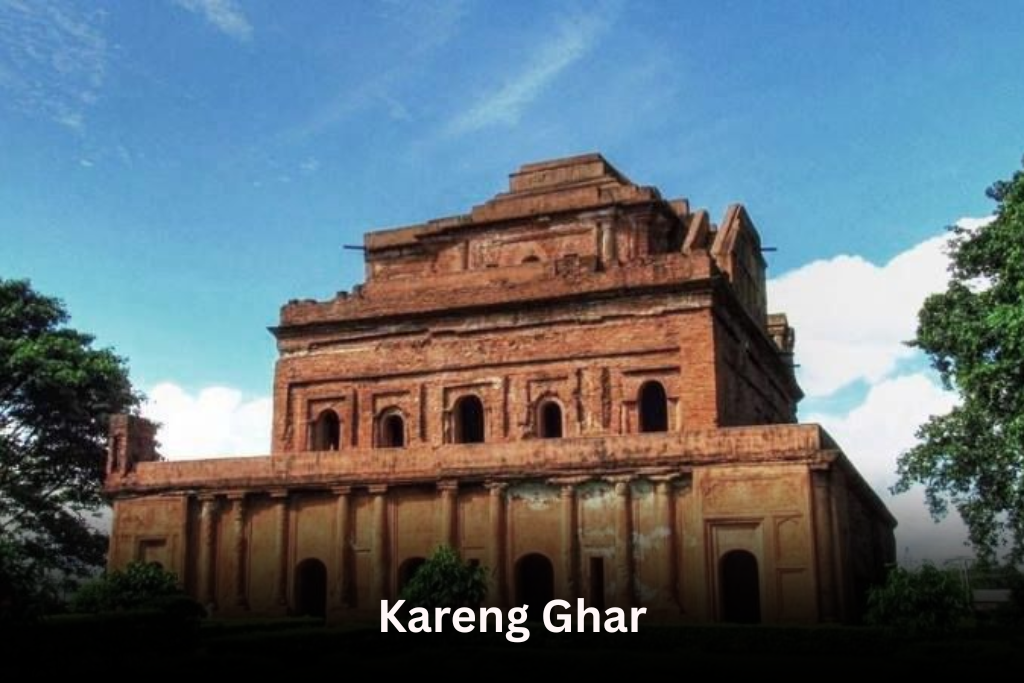
2. Rang Ghar:
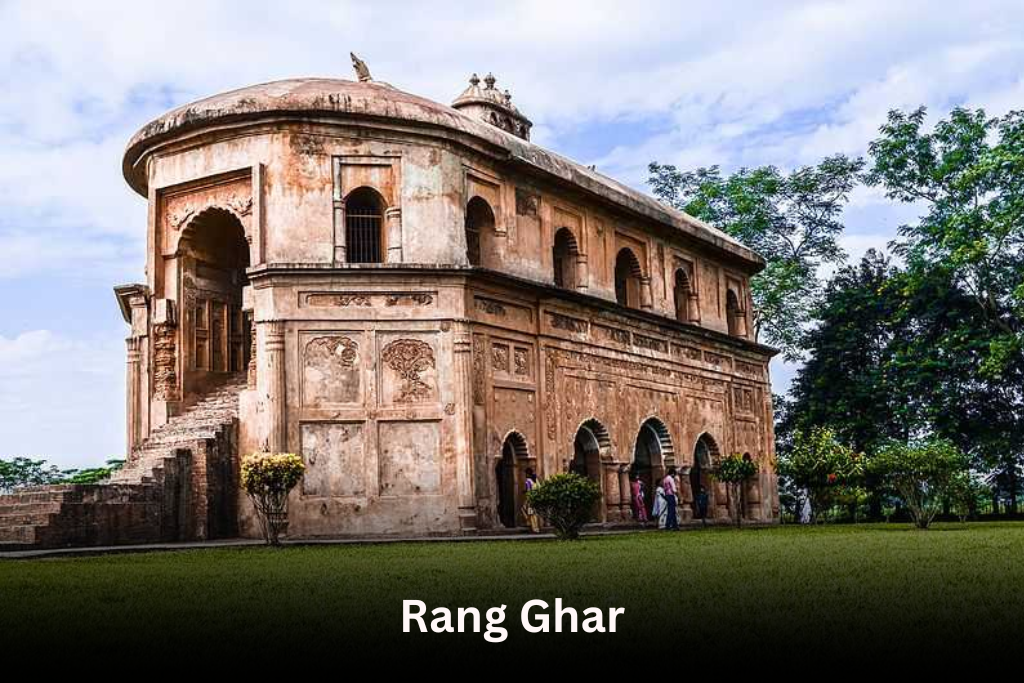
3. Charaideo Royal Burial Mound (Maidams):
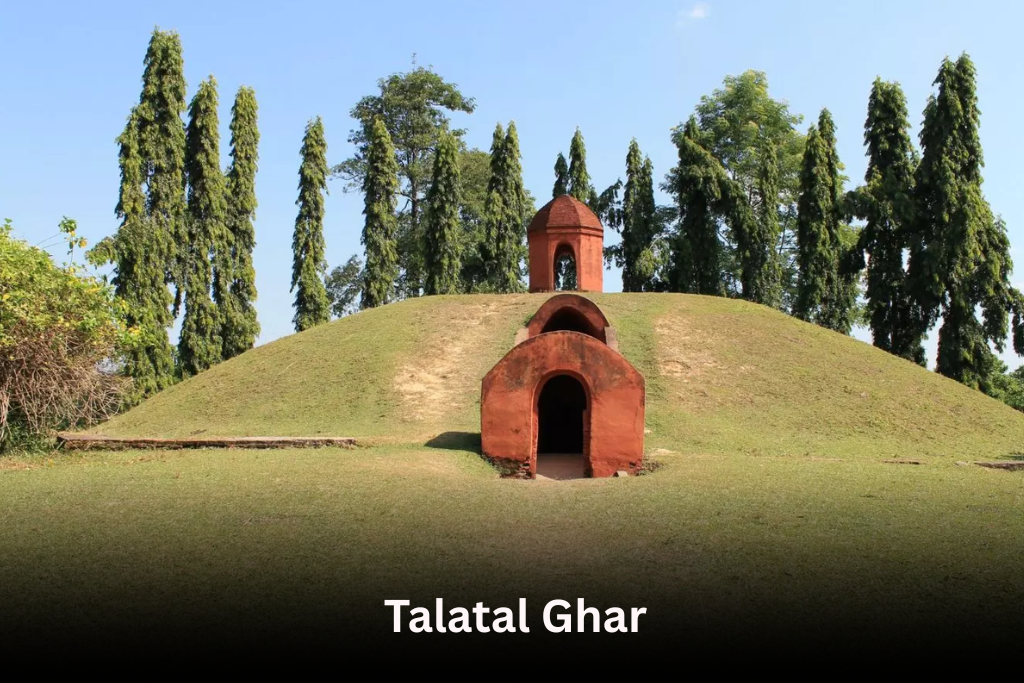
4. Umananda Temple
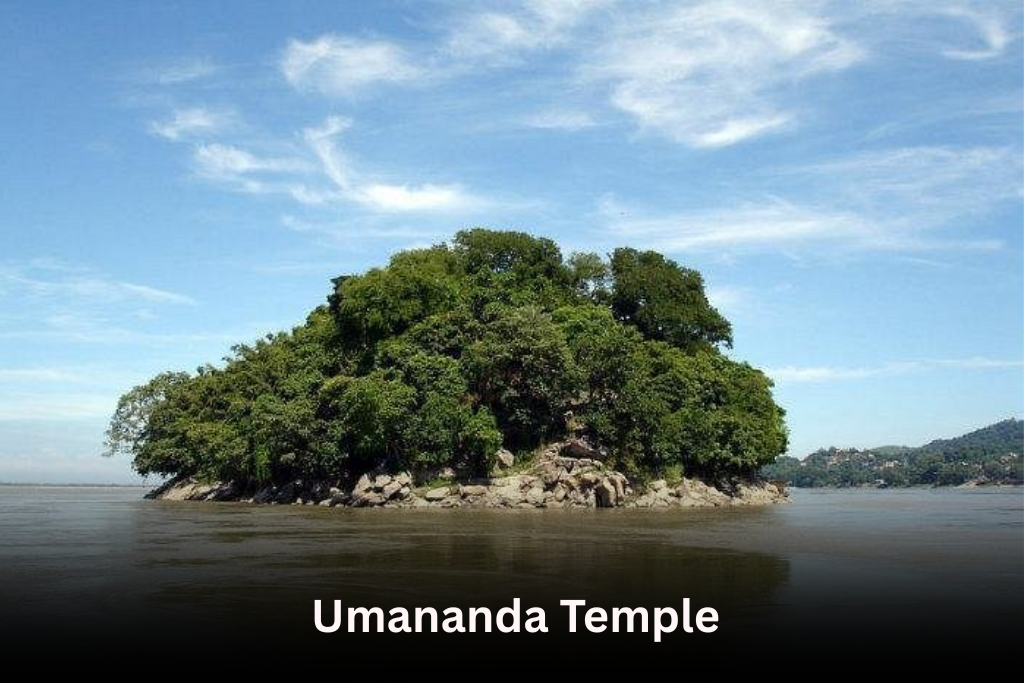
5. Agnigarh Hill
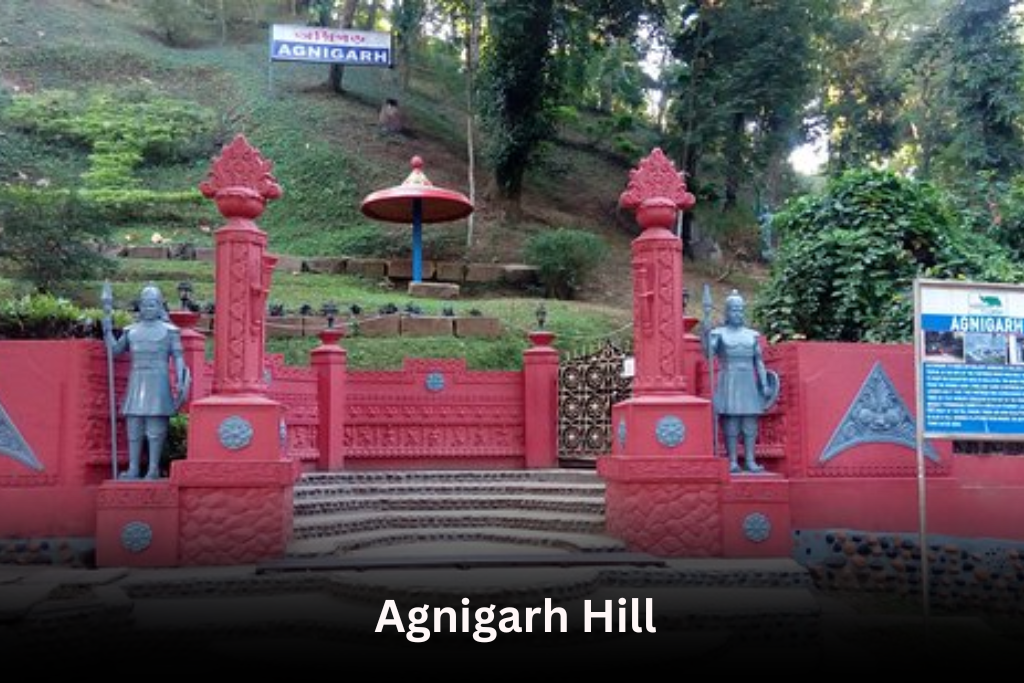
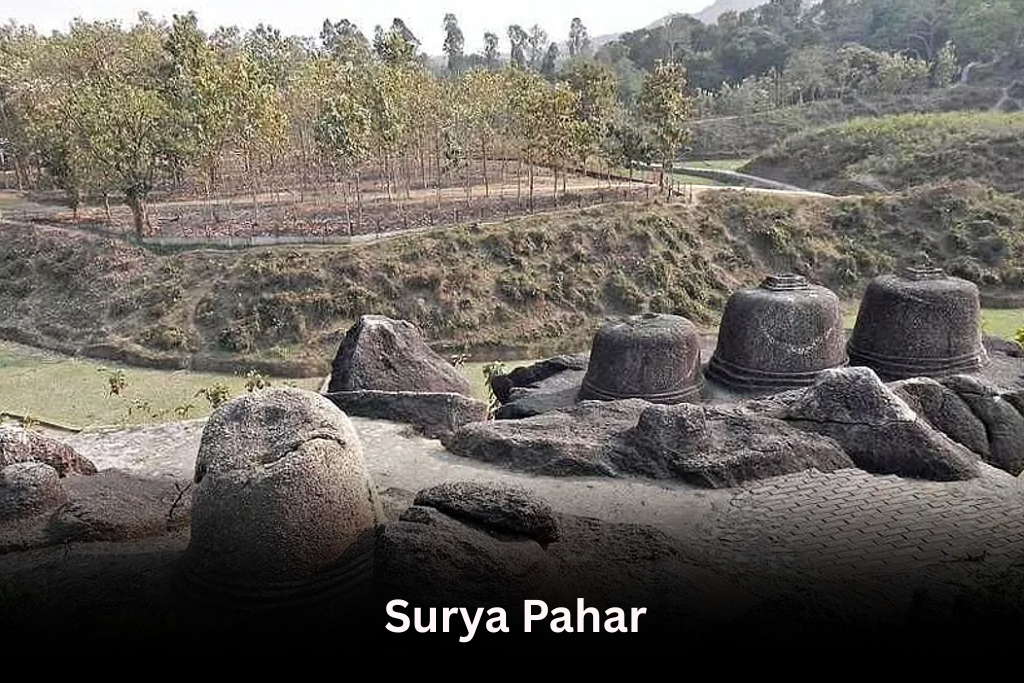
Some Unknown Facts About Districts of Assam
Assam Has a Unique Surname System:
- In several indigenous communities, especially among the Bodos, Dimasas, and Karbis, surnames are derived from clans and not always passed down paternally. Each surname carries historical and clan identity.
India’s First Oil Well Was Drilled Here:
- Digboi in Assam is home to Asia’s first oil refinery, and oil drilling started as early as 1867, even before the discovery of oil in the Middle East.
Largest Home to Wild Water Buffaloes:
- Assam holds the largest population of wild water buffaloes (Bubalus arnee) in the world, primarily found in Kaziranga and Dibru-Saikhowa National Parks.
Assamese Language Has No Gender:
- Unlike Hindi or Sanskrit, Assamese is a gender-neutral language—nouns and verbs do not change based on the gender of the subject.
A Temple Where Tortoises Are Worshipped:
- The Hayagriva Madhava Temple in Hajo is unique for its sacred tank filled with hundreds of endangered black softshell tortoises—revered and protected as divine.
Assam Gave India Its First Female Chief Minister from Northeast:
- Syeda Anwara Taimur of Assam was India’s first and only Muslim woman Chief Minister, leading the state from 1980 to 1981.
Home to the World’s Smallest River Island:
- While Majuli is the largest, Umananda Island in the Brahmaputra (near Guwahati) is believed to be the world’s smallest inhabited river island.
Bihu Dance is Performed in Space (Almost):
- A video of Assamese students performing Bihu at an altitude of 30 km above Earth’s surface (sent via a weather balloon) went viral in 2023 as “the first cultural performance near space.”
Unique Weaving Traditions Passed from Mother to Daughter:
- In Assamese households, especially among the Mising and Assamese communities, a girl is traditionally not considered ready for marriage until she learns weaving on a handloom.
Origin of the Name ‘Assam’:
- The name “Assam” is believed to have evolved from ‘Asama’ (meaning ‘unequal’ or ‘peerless’) in Sanskrit, or from the Ahom dynasty that ruled for nearly 600 years.
Assam is a Seismically Active Zone:
- Assam falls in Zone 5, the most earthquake-prone zone in India. The Great Assam Earthquake of 1950 is one of the strongest ever recorded in India (8.6 magnitude).
Largest Tea Auction Centre in India:
- Guwahati Tea Auction Centre (GTAC) is not just one of the largest in the country, but it also handles the world’s largest volume of CTC tea transactions.
Assam Has the Only Golden Langur Habitat:
- The endangered Golden Langur, once found in Bhutan and Assam, now mainly survives in the Manas National Park and adjacent forest reserves.
Dima Hasao’s Jatinga – The Mystery Village:
- Jatinga is globally famous for its mysterious bird phenomenon, where migratory birds fly to their deaths. It’s still debated whether it’s due to fog, lights, or magnetic disturbances.
Salt Production from Plants:
- The ‘Hmar’ tribe in parts of Assam still follow the rare practice of extracting salt from plant ashes, especially from banana stems.
FAQs
Q: How many districts are there in Assam in 2025?
A: Assam is currently divided into 35 districts as of 2025.
Q: What makes Majuli unique?
A: Majuli is the world’s largest river island and is known for its spiritual significance, Vaishnavite monasteries, and the annual Raas Leela festival.
Q: Which district is considered the Gateway to the Northeast?
A: Kamrup is often referred to as the Gateway to the Northeast due to its historical significance and location.


